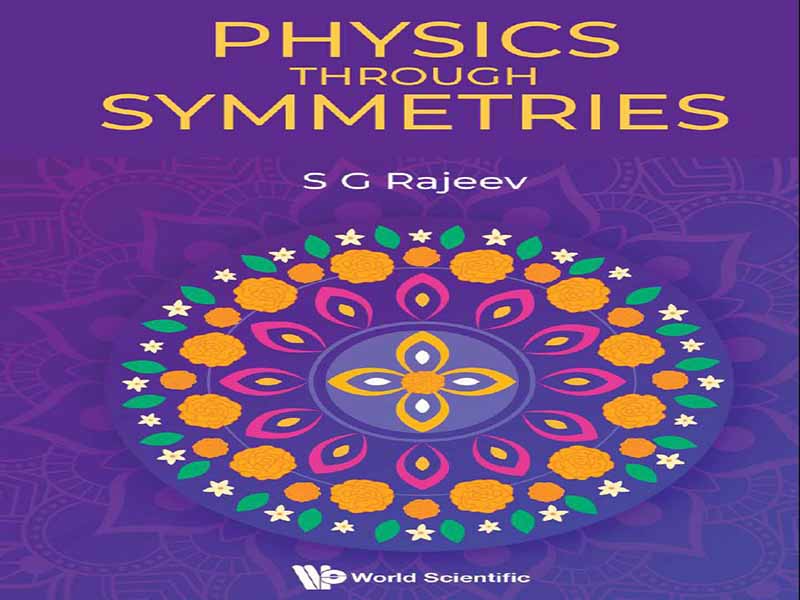- عنوان کتاب: Physics Through Symmetries
- نویسنده: S G Rajeev
- حوزه: نظریه فیزیک
- سال انتشار: 2026
- تعداد صفحه: 334
- زبان اصلی: انگلیسی
- نوع فایل: pdf
- حجم فایل: 2.86 مگابایت
بیش از صد سال است که نظریه گروه نقش اساسی در فیزیک نظری ایفا کرده است. حتی قبل از آن مشخص شده بود که حل بسیاری از سیستمهای مکانیکی (نوسانگر هارمونیک، مسئله کپلر) به دلیل تقارنها امکانپذیر است. ای. نوتر نشان داد که تقارنها حاکی از قوانین پایستگی در مکانیک هستند. گروهها همچنین در طبقهبندی ساختارهای تناوبی (کریستالها) و الگوهای پراش پرتو ایکس آنها مفید بودند. گروهها و نمایش آنها عمیقترین کاربردهای خود را در نظریه کوانتومی یافتند. ویگنر و وایل پیشگامان بودند. گروهها به عنوان ابزاری قدرتمند برای طبقهبندی و درک ذرات و حالتهای آنها در فیزیک هستهای و انرژی بالا عمل میکردند. اساساً، برهمکنشهای بین ذرات بنیادی (نیروهای الکترومغناطیسی و قوی) نتیجه تقارنهای پیمانهای غیرآبلی است. این ایده ریشه در نسبیت عام دارد، جایی که انیشتین دریافت که کوواریانس عمومی منجر به برهمکنشهای گرانشی میشود. بنابراین شما نمیتوانید فیزیک نظری مدرن را بدون دانستن مقداری نظریه گروه درک کنید. این حوزه برای یک نفر بسیار گسترده است که همه چیز را در مورد هر گروه بداند. باید انتخابهایی انجام شود. انتخاب موضوعات من مسلماً شخصی است. من سعی کردهام به جای تکنیکها (فهرست نمایشهای غیرقابل تقلیل، محاسبه ناورداهای کازیمیر و غیره) بر مفاهیم (نظریه لی، قضیه پیتر-ویل و غیره) تأکید کنم. در حال حاضر کتابهای بسیار خوبی وجود دارد که میتوانند شما را در تکنیکها آموزش دهند. ناگفته نماند که منابع آنلاین مختلفی (ویکیپدیا، اسکالرپدیا و غیره) خلاصهای سریع ارائه میدهند. با مطالعه عمیق چند مورد نمونه، میتوان درک خوبی به دست آورد. حتی اگر در تحقیقات خود با موارد مختلفی روبرو شوید، دانش به دست آمده اغلب قابل تطبیق است. همچنین نشانههایی وجود دارد که فیزیکدانان آینده به تقارنهایی نیاز خواهند داشت که فراتر از گروهها باشند. جذابترین آنها «گروههای کوانتومی» هستند. بنابراین آنها را گنجاندهام. سعی کردهام از تقارنهایی که نظریهپردازان دوست دارند، اما پشتیبانی تجربی زیادی پیدا نکردهاند، اجتناب کنم. کاش زمان بیشتری برای انجام کارهای بیشتر وجود داشت. از جمله مواردی که بیشتر از همه بابت آنها پشیمانم عبارتند از: مدارهای مشترک، جبرهای ویراسورو و کاک-مودی و نظریه نمایشهای واحد هریش-چاندرا از گروههای غیرفشرده. این کتاب برای خواندن خطی و از ابتدا تا انتها نیست. چندین بخش را میتوان در اولین خواندن حذف کرد؛ وقتی بعداً به آنها برگردید، بیشتر متوجه خواهید شد. آنها با یک ستاره در عنوان بخش مشخص شدهاند. فصلهای بعدی مختصرتر و از نظر فنی پیچیدهتر هستند. همچنین میتوان آنها را در اولین خواندن حذف کرد. هرچه مثالها و تمرینهای بیشتری حل کنید، درک شما بهتر خواهد شد. برخی از تمرینها با جزئیات حل میشوند. اما فقط پس از یک تلاش جدی به راهحل نگاه کنید. دانش و درک من از نظریه گروهها از معلمم، ای. پی. بالاچاندران، است؛ که با تعاملات بعدی با مارک بوویک، فزا گورسی و سوسومو اوکوبو تقویت شده است. همچنین مدیون راکش تیبروالا هستم که بیشتر کتاب را با دقت فراوان خواند. نظرات او بسیار مفید بود. البته، من مسئولیت هرگونه اشتباه یا ابهامی را که باقی مانده است، میپذیرم. همچنین از کریستوفر بی دیویس و رحیمی بی واهاپ از انتشارات ورلد ساینتیفیک به خاطر تشویق و شکیباییشان در طول روند کند نگارش کتاب، سپاسگزارم.
For over a hundred years, group theory has played an essential role in theoretical physics. Even before that it was known that the solution of many mechanical systems (harmonic oscillator, Kepler problem) are possible because of symmetries. E. Noether showed that symmetries imply conservation laws in mechanics. Groupswere also useful in classifying periodic structures (crystals) and their X-ray diffraction patterns. Groups and their representation found its deepest uses in Quantum Theory. Wigner and Weyl were the pioneers. Groups served as a powerful tool to classify and understand particles and their states in nuclear and high energy physics. More fundamentally, interactions among elementary particles (electromagnetic and strong forces) turn out to be a consequence of non-abelian gauge symmetries. This idea has its roots in General Relativity, where Einstein found that general covariance leads to gravitational interactions. So you cannot understand modern theoretical physics without knowing some group theory. The field is too broad for one person to know everything about every group. Choices must be made. My choice of topics is admittedly personal. I have tried to emphasize the concepts (Lie theory, Peter-Weyl Theorem etc.) instead of techniques (listing of irreducible representations, calculation of Casimir invariants etc.). There are already excellent books that could train you in techniques. To say nothing of various online resources (Wikipedia, Scholarpedia etc.) that give a quick summary.Agood understanding can be obtained by studying a few representative cases in depth. Even if you encounter different cases in your own research, the knowledge so obtained can often be adapted. There are also indications that future physicists will need symmetries that go beyond groups. The most intriguing of these are “quantum groups”. So I have included them. I have tried to avoid symmetries that theorists love, but which have not found much experimental support. I wish there was time to do more. Among the omissions I regret most are: Coadjoint orbits, Virasoro and Kac-Moody algebras and Harish-Chandra’s theory of unitary representations of non-compact groups. The book is not meant to be read linearly, cover to cover. Several sections can be omitted in a first reading; they will make more sense when you return to them afterwards. They are denoted by a star in the section heading. The later chapters are more terse and technically involved. They can also be omitted in a first reading. The more examples and exercises you work out the better your understanding will be. Some of the exercises are solved in detail. But look at the solution only after a serious attempt. My own knowledge and appreciation of group theory is from my teacher, A. P. Balachandran; augmented by later interactions with Mark Bowick, Feza Gursey and Susumu Okubo. I owe a debt of gratitude also to Rakesh Tibrewala, who read most of the book with great care. His comments were very helpful. Of course, I own entirely any mistakes or confusions that remain. Thanks also to Christopher B Davis and Rhaimie BWahap ofWorld Scientific for their encouragement and patience through the slow process of writing the book.
این کتاب را میتوانید از لینک زیر بصورت رایگان دانلود کنید:
Download: Physics Through Symmetries




































نظرات کاربران